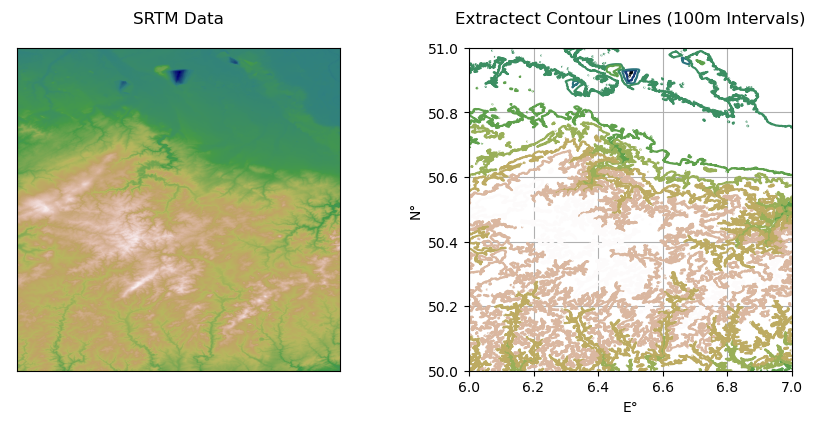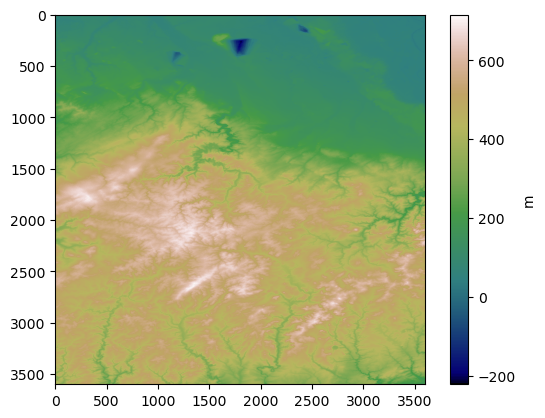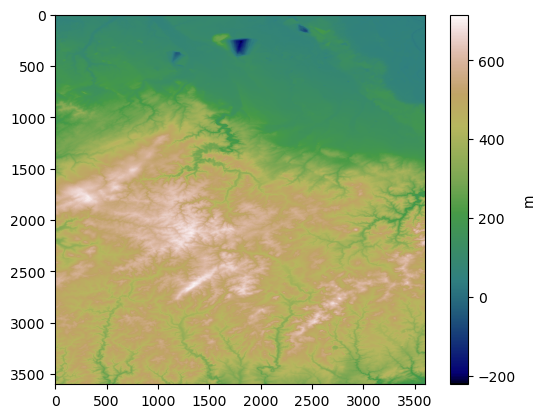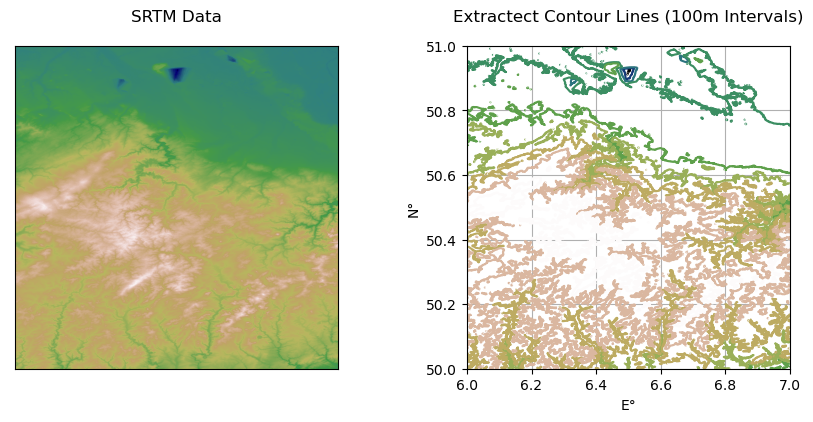62 Extracting contour lines from raster
Contents
62 Extracting contour lines from raster#
The following notebook illustrates how to extract contour lines from a raster utilizing Rasterio, Shapely and Geopands.

Set File Paths and download Tutorial Data#
If you downloaded the latest GemGIS version from the Github repository, append the path so that the package can be imported successfully. Otherwise, it is recommended to install GemGIS via pip install gemgis and import GemGIS using import gemgis as gg. In addition, the file path to the folder where the data is being stored is set. The tutorial data is downloaded using Pooch (https://www.fatiando.org/pooch/latest/index.html) and stored in the specified folder. Use
pip install pooch if Pooch is not installed on your system yet.
[12]:
import gemgis as gg
file_path = 'data/62_extracting_contour_lines_from_raster/'
[13]:
gg.download_gemgis_data.download_tutorial_data(filename="62_extracting_contour_lines_from_raster.zip", dirpath=file_path)
Loading the data#
For this tutorial a SRTM DEM with a resolution of 30 m showing the area around Aachen and the High Fens - Eifel is used. SRTM data is provided by the LP DAAC (https://lpdaac.usgs.gov/product_search/?collections=MEaSUREs+SRTM&view=list&sort=title), which is responsible for the distribution of NASA MEaSUREs data, and can be downloaded for free from different website or through different GIS plugins.
As the GemGIS function extract_contour_lines_from_raster is able to work with .tif files, raster.io objects and np.ndarrays, multiple ways of loading the data will be shown below.
1) Loading the data as a raster.io object#
[30]:
import rasterio
raster = rasterio.open(file_path + 'N50E006.tif')
raster.read(1)
[30]:
array([[ 80, 81, 82, ..., 46, 46, 45],
[ 81, 81, 81, ..., 45, 45, 46],
[ 80, 80, 81, ..., 47, 47, 47],
...,
[399, 400, 402, ..., 197, 196, 194],
[395, 395, 396, ..., 197, 196, 194],
[391, 391, 390, ..., 196, 195, 194]], dtype=int16)
If the raster is loaded as a raster.io object, the extent and CRS can be extractet easily.
[31]:
raster_extent = raster.bounds
raster_extent
[31]:
BoundingBox(left=5.999861111, bottom=49.999861111, right=7.000138889, top=51.000138889)
[32]:
raster_crs = raster.crs
raster_crs
[32]:
CRS.from_epsg(4326)
[33]:
import matplotlib.pyplot as plt
im = plt.imshow(raster.read(1), cmap ='gist_earth')
cbar = plt.colorbar(im)
cbar.set_label('m')

2) Loading the data as an np.ndarray#
[27]:
import numpy as np
raster = np.load(file_path + 'raster_array.npy')
Plotting the raster#
[19]:
import matplotlib.pyplot as plt
im = plt.imshow(raster, cmap ='gist_earth')
cbar = plt.colorbar(im)
cbar.set_label('m')

Extracting Contour Lines#
For extracting the contour lines from the raster, it is necessary to provide the raster data as well as the extent from which the contour lines are supposed to extractet from, the crs of the raster and the interval with which contour lines are supposed to be extractet.
For the chosen example for this tutorial, the extent will be set to the SRTM DEM extent, CRS to EPSG:4326 and the interval will be set to 100 meters.
If raster was loaded as raster.io object#
[37]:
gdf_lines = gg.raster.extract_contour_lines_from_raster(raster= raster,
interval = 100)
If raster is present as .tif file#
[39]:
gdf_lines = gg.raster.extract_contour_lines_from_raster(raster= file_path + 'N50E006.tif',
interval = 100)
If raster is present as ndarray#
[28]:
gdf_lines = gg.raster.extract_contour_lines_from_raster(raster= file_path + 'N50E006.tif',
extent=(5.99, 7.00, 49.99, 51.0),
target_crs='EPSG:4326',
interval = 100)
Plotting Contour Lines#
With the contours extractet they can now be easily plotted
[46]:
fig, ax = plt.subplots(1,2, figsize = (10,10))
fig.subplots_adjust(wspace = (0.4))
ax[0].imshow(raster.read(1), cmap ='gist_earth')
ax[0].set_xticks([])
ax[0].set_yticks([])
ax[0].set_title("SRTM Data", y= 1.05)
gdf_lines.plot(column = 'Z', ax = ax[1], cmap ='gist_earth')
ax[1].set_aspect("equal")
ax[1].set_xlabel("E°")
ax[1].set_ylabel("N°")
ax[1].grid()
ax[1].set_xlim(6, 7)
ax[1].set_ylim(50,51)
ax[1].set_title("Extractect Contour Lines (100m Intervals)", y= 1.05)
[46]:
Text(0.5, 1.05, 'Extractect Contour Lines (100m Intervals)')

